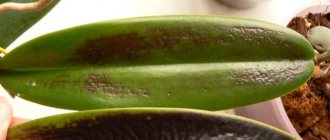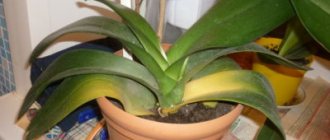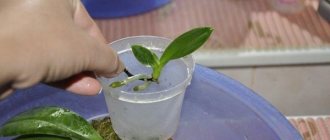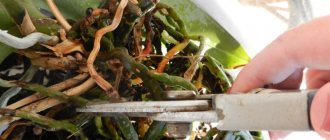Under natural conditions, orchids are fixed to the surface using a virtually open root system.
The roots grow widely, absorbing atmospheric moisture and carrying out the process of photosynthesis under the influence of light.
Indoors, orchid growing conditions are often far from natural.
In this case, the external signs of the plant will tell you what the plant is missing .
Why does improper root growth occur?
Improper root growth occurs for a number of reasons, each of which is associated with unfavorable growing conditions.
High temperature content
Cultivating an orchid in high temperatures often leads to drying out of the substrate . In search of moisture, the roots grow in different directions.
Over or under watering
The main reason for the massive development of aerial roots in an orchid is low air humidity . To prevent unfavorable processes, it is necessary to control the conditions of its growth, especially in winter.
As a rule, at this time the problem is associated with central heating radiators , which dry the air when turned on. The problem is especially acute in the window sill area, where flowerpots with orchids are usually located. In this case:
- the orchid is removed from sunlight or away from radiators;
- to maintain natural moisture, aerial roots are covered with moss;
- water only with soft water.
The opposite of underwatering is overwatering, which leads to lack of oxygen and rotting roots and also promotes the growth of aerial roots, which are thus saved from death.
Excessively dense soil
An improperly prepared substrate often provokes massive growth of aerial roots due to:
- poor air ventilation and oxygen starvation;
- waterlogging and root rotting.
In this case, the plant should be transplanted into a new substrate and the watering regime adjusted.
Lack of lighting
Insufficient lighting is one of the main factors leading to a decrease in plant immunity, diseases and root rot. To adapt to these conditions, the orchid grows numerous aerial roots that grow upward.
Description of the phalaenopsis orchid
The variety of orchid species emphasizes their appearance. They are ordinary, reaching a height of 1 m, and miniature - up to 30 cm in height. The vertical stem is shortened, and the dense leathery leaves are collected into a rosette. Peduncles and aerial roots are produced in the axils between the leaves. A sign of an adult plant is the presence of 4-6 leaves up to 20-30 cm long. Peduncles can branch heavily. A blooming orchid resembles a long branch on which a whole flock of exotic tropical butterflies is located, strictly in order. An unusually long flowering period - up to 4 months - brings a feeling of celebration to endless everyday life. Different types of orchids bloom at different times; proper care ensures 2-time flowering.
What can improper root growth cause?
Under unfavorable conditions, aerial roots are subject to various disturbances and infections.
Drying roots
This situation can be caused by:
- improper watering of the flower;
- humidification with water with a high salt concentration;
- weak watering during hot periods;
- excessive feeding.
Modern fertilizers are a concentrate of mineral elements, the wrong dosage of which can cause burns on the roots.
The appearance of mold
Mold on the roots is the first sign of the appearance of an infectious fungus . Its development is stimulated by a number of factors, especially quickly when exposed to the following:
- low temperature;
- overwatering;
- lack of light.
If the mold has affected only the soil and has not affected the root system, then:
- the top layer of soil is loosened and dried;
- Watering is carried out only after the soil has completely dried.
If mold has already captured the root system , the orchid must be replanted:
- the roots removed from the soil are washed under running warm water;
- remove diseased and dried ones;
- immerse the root system in the fungicide for 20 minutes.
The plant is planted in a prepared new substrate.
Redness of the root tips
This is not a disease or problem and occurs as a result of normal root growth.
Woodenness
The appearance of very hardened and woody roots occurs during the process of their natural aging . In this form, they often cause root infections, so they need to be pruned.
Rust or blackening of aerial roots
In some cases, blackening or a rusty color on the surface of the aerial roots due to salt deposition. This happens:
- when watering with water with high mineralization , when the roots in the middle of the pot do not have time to become saturated with moisture;
- with incorrect dosage of fertilizer , which results in burns to the roots or improper fertilizing. To prevent this from happening, apply fertilizer immediately after watering the orchid.
If the air in the room is dry, the situation may worsen sharply, so the following actions should be carried out immediately:
- the flowerpot is placed on a damp stand with pebbles, sand, moss, or a humidifier is regularly turned on;
- Irrigate only with low-salt water.
soften water at home using:
- special water filters;
- by adding 3 g of wood ash or 100 g of fresh peat to the water, which are stirred in 10 liters of water.
To prevent it from forming, the plant must be watered exclusively with soft water (melt, rain or settled water).
The appearance of pink or red areas on the roots
The following areas appear:
- in the hot season as a special tanning of the roots;
- as a result of fusarium.
Fusarium is an infectious disease caused by microscopic fungi. The disease manifests itself in softening of the roots, yellowing of the leaves and often ends in the death of the plant.
How to replant a phalaenopsis orchid
Preparations for replanting should begin with the selection of a pot, which will become a new comfortable and bright home for the flower. Precisely light, since controlling the humidity of the substrate and monitoring the condition of the root system is half the success in growing an orchid. The transparency of the walls of the pot is also crucial because the roots develop better in the light. So, when deciding how to transplant a phalaenopsis orchid, you should keep in mind that you need to choose a transparent plastic or glass vessel with holes on the side and bottom, the size of which is 1.5-2 cm in diameter larger than the previous one. It should be remembered that you cannot quickly increase the capacity of the pot - the roots will grow uncontrollably, which can negatively affect the appearance of flowers and the duration of flowering.
What to do if the orchid roots have come out of the pot and are growing upward?
All actions should be aimed at normalizing the care of the orchid.
Adjusting the watering mode
To avoid problems with the roots, the substrate must dry completely between waterings. In the summer season, it is recommended to water the flower 2-3 times a week, in winter - no more than once every 10 days.
Important. When watering, first of all, they focus on the condition (humidity) of the substrate in the pot, and not on the recommended frequency of watering.
To saturate the orchid with moisture, do not water the plant from a watering can . In this case, water passes through the soil, only slightly wetting the roots. Proper watering is carried out by immersing the plant in a container of water for 10-15 minutes. or carry out abundant sprinkling from the shower.
Increase lighting
Orchid loves a large amount of diffused light , which will allow the roots to grow and develop normally:
- in autumn and winter, daylight hours should be extended to 12 hours using a fluorescent lamp;
- In order not to cause burns to the roots, the plant is protected from direct sunlight by slightly darkening the south window with plastic, matte film or any other material.
Comfortable lighting also helps strengthen the orchid's immunity.
Don't trim
There is no need to remove aerial roots or push them into a pot, as novice gardeners often do . Pruning is carried out only when rotting or other diseases of the roots are detected.
If the flower is cramped in the pot, replant it
Considering the negative factors that are associated with insufficient pot volume or too dense a substrate (oxygen starvation of the roots, waterlogging), the orchid should be replanted .
Compliance with the requirements of orchid cultivation does not require special skills. Even if problems arise, taking care of the plant will help restore the beautiful appearance of the orchid.
A little about amazing flowers
Having appeared in Hawaii and spread in the tropical forests of Australia and New Zealand, in the Amazon in South America, the orchid has become the heroine of many legends of different nations. Thanks to its exquisite beauty and incredible delicacy, this plant is one of the most sought after, actively collected and protected in the world. Probably, the Orchid family has the largest number of representatives, it has from 20 to 30 thousand species. Breeders all over the world have a weakness for this amazing flower, so a huge number of different varieties, shapes and shades of flowers are added every year. Breeding these exotic plants is an exciting activity that more and more lovers of charming orchids are doing today.
Useful tips
When planting an orchid, a five-centimeter layer of drainage made of expanded clay , perlite or polystyrene foam balls is poured onto the bottom of the pot. A prepared soil mixture 5-6 cm high is laid on top, and an orchid is placed on it.
The roots are covered with substrate and the pot with the plant is lowered into a container of water for a few minutes. We hope that after reading our article it becomes clearer to you what to do with orchid roots that grow outward. If you have any questions, write them in the comments, we will try to answer!
Caring for orchids: how to do it right?
It is believed that these original flowers are very capricious and demanding, but proper care is not a complicated procedure at all, but daily observation and assistance to the plant when it is needed. Amateur flower growers have the largest number of questions regarding transplantation. How to replant a home orchid, what substrate is best to use, when to wait for flowering and how to avoid diseases? Here is an incomplete list of questions that arise when buying an exotic flower. In this article, we will look at all agrotechnical techniques and learn how to replant a phalaenopsis orchid.
Transfer
When all the preparatory stages have been completed, the question of how to replant an orchid after purchase is easily resolved. A suitable new pot is partially filled with the substrate, the roots are carefully laid and the soil is sprinkled with soil as evenly as possible. Then the contents are carefully compacted and soil is added. Roots that previously grew outside the pot should be left as open as possible.
The basic rule for proper transplantation is not to bury the plant. On the ground surface, it is necessary to leave the base as high as possible. Under no circumstances should the roots and growing point be covered with moss or substrate from above, this will lead to rotting. Flower growers give the same recommendations when the question arises about how to replant an orchid after flowering. In this case, you need to cut off the dried flower stalks and adhere to the already indicated algorithm of actions.
Taking into account the peculiarities of planting, the plant in the pot should be well strengthened. This is probably where the exactingness of this exotic flower manifests itself. The slightest mechanical vibration or swaying can nullify all efforts, since the growing ends of the roots are very sensitive and instantly stop growing with the slightest abrasions and wounds that injure the shell. The plant is secured with thin wooden or plastic sticks, which must also be handled very carefully.
The procedure is greatly simplified if the orchid has sprouted. How to transplant and strengthen it has already been said in the article. We repeat: small roots mean small worries.
You need to carefully place the sprout in a new small pot and secure it in the substrate. Unlike many houseplants, the orchid does not need to be watered after planting. You should maintain a dry regime for at least a week.
Other reasons for replanting an orchid
Sometimes situations arise when you cannot wait, and you have to replant the orchid immediately, regardless of the flowering period, root activity or inappropriate season. The most convincing reason for an unexpected transplant of phalaenopsis is the inadequacy of the substrate. If it has decomposed and crumbled into dust, then air access to the epiphytic roots is significantly hampered, and the lack of proper ventilation leads to diseases of the roots and the plant as a whole. Another reason may be the initial planting of the flower in soil that does not meet its needs: it may be overly acidic, spoiled by low-quality fertilizers or water.
Having a transparent pot will allow you to see in time the negative changes occurring in the roots. And this is another reason to help the plant as quickly as possible, before the irreversible processes of rotting and death of the orchid begin.
Inspecting the plant before planting
Having understood how to transplant an orchid into a pot, you should carefully examine the plant, be sure to remove adhering soil and areas of roots with rot, otherwise it will subsequently spread to the entire root system and destroy the flower. The tool used (scissors or pruning shears) must be disinfected, but knowledgeable gardeners advise doing all operations with dry hands, which avoids infection. It is also not recommended to wet the roots with water. All operations should be carried out “dry”. After removing the rotten areas, you can treat all sections with crushed coal or special antiseptic substances.
If the orchid has grown greatly, it makes sense to divide the plant into several parts, each of which is then processed and planted in separate pots.
Selecting the right soil
The orchid's favorite substrate is a mixture of crushed tree bark with the addition of charcoal, perlite and sphagnum moss. To calculate the proportions of parts of the soil, you should take into account the conditions of the plant. If the atmosphere in the house is dry, which occurs when central heating batteries are connected in winter, the amount of moss should be increased to a third of the total volume: it absorbs water, holds it and subsequently releases it to the roots, preventing the orchid from drying out. Growing phalaenopsis in a greenhouse, where the humidity is quite high, involves reducing the amount of moss to 5-10%. Charcoal at any humidity makes up 10% of the total volume. It prevents rot from occurring on the roots. Perlite in the same proportions prevents the soil from caking. If you are unsure about the correct preparation of the soil mixture, you can use a ready-made substrate purchased in a store yourself. You just need to clarify the purpose of the soil; the packaging should contain the inscription “for phalaenopsis and other epiphytes.”











